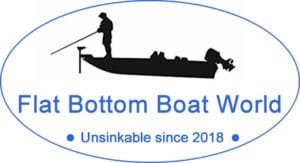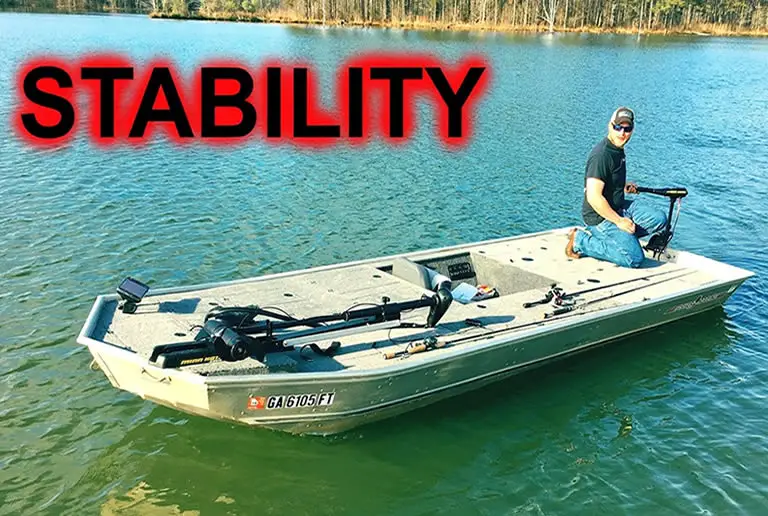Flat bottom boats offer many advantages over boats with a different hull design. However, their flat bottom and shallow draft can create stability issues in certain environments and under conditions. Likewise, a V hull boat has certain advantages over a flat bottom boat but will have stability issues in certain environments and under certain conditions.
Contents
V Hull vs Flat Bottom Boats. Where & How They Are Best Used
In this article I highlight the type of marine environments and weather/water conditions that each boat type is best suited to.
I also outline the design characteristics of each boat that make them unsuitable for certain marine environment and weather/water conditions.
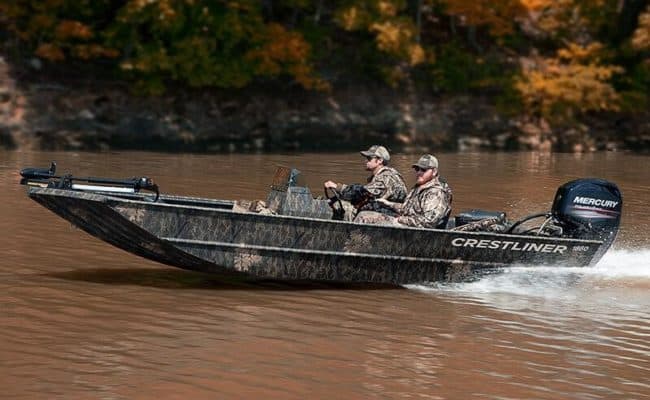
By the time you reach the end of this article you will be armed with enough knowledge to be able to easily identify which type of boat is a better fit for you.
How Stable Are Flat Bottom Boats?
Flat bottom boats are very stable in calm waters.
They are much more stable when used in calm inland waters than v hull boats.
In fact, in calm conditions a flat bottom boat offers the most stability of any vessel.
Instability issues arise only when these boats are used in unsuitable waters and/or in adverse weather conditions.
How a flat bottom affects boat stability
Flat bottom boats are designed to navigate shallow calm waters.
For this reason they are best suited to inland waterways.
They offer a lot of advantages over other boat types but they also come with their challenges.
If you need a better understanding of the design features of a flat bottom boat read the article What is a Flat Bottom Boat.
Although some owners do take their flat bottom boats on open seas, such as Jon boat owners, this is only advisable in extremely calm weather and you should never venture far from the shoreline.
Flat bottom boats are not considered seaworthy.
Flat bottom boats, such as Jon boats, scows and some skiffs have an almost flat bottom and a shallow draft.
This allows these unique boats to traverse very shallow waters where boats with deeper shallow hull designs would be unable to go.
The flat bottom offers other advantages too.
On calm waters a flat bottom boat offers an exceptionally smooth ride even at speed.
A flat bottom boat rides on top of the water encountering very little friction while most other boats slice through the water creating friction and a somewhat bumpy ride.
It is also possible to walk around the deck of a flat bottom with almost no stability issues.
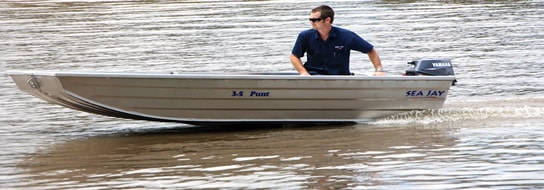
These advantages make a flat bottom boat very useful for a number of different water-based activities.
Here are just a few:
- Barge transport along shallow rivers and canals.
- Transportation of goods and people on inland waterways.
- Utility work on rivers and canals.
- Fishing in shallow waters.
- Hunting in shallow rivers and lakes.
However, the advantage of being able to navigate shallow waters, and the added stability and comfort that a flat bottom boat offers on calm waters, comes at a price.
The price comes in the form of limited use.
A flat bottom boat is only suitable to use in certain weather conditions and in specific environments.
A flat bottom boat, such as a Jon boat, is stable when:
- It is used on calm inland waters (usually fresh water though inland saltwater use is fine).
- The weather is fair.
- There are no, or very slight, waves.
- You walk across, or stand upright on, the deck.
Stability issues with a flat-bottomed boat arise when:
- The boat is used in inappropriate environments (such as choppy open seas).
- Windy conditions create very choppy waters.
- The boat is overloaded.
- Weight on the boat is distributed unevenly.
There are ways to stabilize flat bottom boats from the extreme measure of modifying the hull (not recommended) to adding floatation devices to the boat at key points along its hull.
These methods for making a flat bottom boat more stable are only suitable for smaller recreational craft such as Jon boats.
Attempting to stabilize a scow or barge using these techniques would prove to be fruitless.
Adding stability to a Jon boat is covered in more detail in a separate section below.
If you need a better understanding of what a Jon boat is and what it is used for read this article.
Flat bottom boat stability issues
Arguably the most popular flat bottom boat in North America is the Jon boat.
This amazingly versatile vessel is used for every type of inland waterway activity you can think of. It is used for everything from the transportation of goods and people to fishing, hunting and utility work, such as water maintenance in public and private waters.
In calm inland waters a Jon boat is incredibly stable and like other flat bottom boats offers an exceptionally smooth ride even at top speed.
However, like other flat bottom boats a Jon will experience stability issues if it is used in the wrong environment for which it was not designed and/or in adverse weather conditions.
Although many Jon boat owners will take their vessel onto the open sea, a Jon boat is not considered seaworthy for the many reasons we outlined in this article.
As a fishing and hunting vessel a Jon boat offers great stability on calm inland bodies of water.
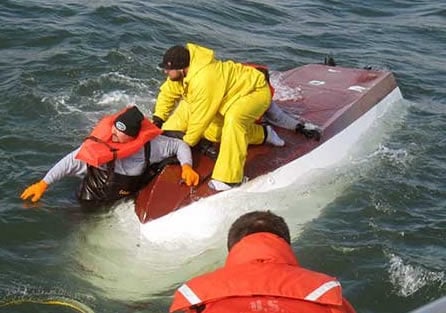
Problems only arise if the boat is used in very choppy waters where the wind starts creating challenging waves.
A Jon boat, like all flat bottom boats, has not been designed to handle rough water.
In open waters with large waves, like the ocean in windy weather, being in a Jon boat can be dangerous as it will probably sink.
As long as you use a Jon boat in the appropriate environments and in reasonably calm weather it will be very stable.
How to stabilize a flat bottom boat
You may have control over where you use your flat bottom boat but obviously you have no control over the weather.
Some boat owners live in areas where the weather can change suddenly and drastically.
Therefore, for many owners having the ability to make their Jon boat more stable has its advantages.
There are several ways to do this.
Some ways to stabilize a flat bottom boat include:
- Modifying the hull to form a semi-v (not advisable as it requires more work than it’s worth. Better to buy a modified one).
- Making modifications to the boat to widen it (much easier to do especially with aluminum or wooden boats).
- Attaching flotation devices such as PVC tubing to the sides, (the most common, cheapest and most effective option and it’s the easiest modification to make). I demonstrated how to do it here.
Some Jon boat owners will modify the hull of their vessel to give it a slight V-shape. These hulls are known as semi-v hulls.
A semi-v hull Jon boat offers some of the advantages of a full-v boat while also retaining some of the advantages of a standard flat-bottomed Jon.
A semi-v hull means the boat will have a much shallower draft than a full-v, allowing the boat to navigate shallower waters like a flat-bottomed boat.
But, the semi-v shape offers much more stability than a flat bottom hull in choppy waters, thus letting the boat owner use the boat in fairly shallow but more challenging weather conditions.
Just be aware that the boat may not be able to access the same very shallow waters that your flat bottom boat can.
Although completing this type of modification at home is possible it involves a lot of work and your boat may be out of the water longer than you’d like.
Unless you really enjoy this type of DIY it is much more cost effective and time-saving to simply buy a modified semi-v from a reputable manufacturer.
A boat’s width also has an effect on its stability.
Widening a Jon boat will greatly increase its stability in all conditions especially in choppy waters.
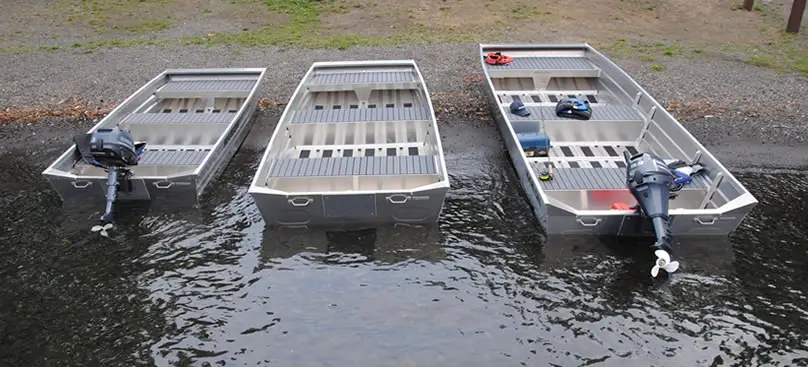
Attaching flotation devices, such as PVC Tubing, to the side of a Jon boat is by far the easiest modification you can make to stabilize the boat.
Attaching flotation devices, like outriggers, is a very effective and low-cost solution if you experience regular stability issues.
Overloading your boat also has a negative effect on stability.
We have covered the subject of improving stability in much more detail in the article How to Make a Jon Boat More Stable.
How Stable Are V Hull Boats?
V hull boats are extremely stable in deep water and have superior stability over flat bottom boats in turbulent water.
They are less stable than flat bottom boats in calm water and cannot access shallow water.
How the v shape hull affects stability
A v shape hull allows a boat to slice through waves and gives it much more stability in turbulent waters.
Where a flat bottom boat sits on top of the water and offers superior stability in calm waters, a v hull boat sits in the water (with a large portion of its underside beneath the waterline).
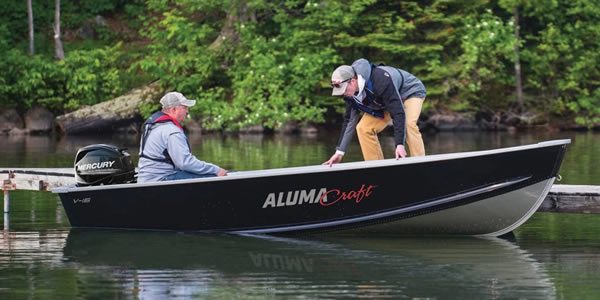
Sitting deeper in the water, with wider curved sides, a v hull boat is able to rock with turbulent water much better than a flat bottom boat with straight sides.
A v hull boat is also better able to slice through waves and is much safer in deeper turbulent waters.
These advantages make a v hull boat very useful for a number of different water-based activities.
Here are just a few:
- Ocean fishing.
- Transportation of goods and people on turbulent waterways.
- Utility work on turbulent deep rivers.
- Fishing in deep waters.
This ability to boat in more turbulent waters means that a v hull boat is more suitable for rougher water but with the good also comes the bad.
With every advantage there is often a disadvantage.
There are some disadvantages to using a v hull boat, especially if you often launch in inland bodies of water such as lakes, rivers and creeks.
A v hull boat, such as a rowboat, is stable when:
- It is used in deep waters (usually the ocean or deep lakes).
- The weather is challenging.
- There are large waves.
V hull stability issues
Although a v hull boat offers superior stability in challenging waters this comes at price.
The price is instability on calm water and an inability to be used in shallow waters.
This rules out large portions of inland waterways such as creeks, small rivers, ponds and many lakes.
Stability issues with a v hull boat arise when:
- The boat is used in inappropriate environments (such as very calm shallow water).
- The water is very calm (the boat will feel very tippy).
- You try to stand up or walk across the deck.
As you can see, just as there is with a flat bottom boat, there are both advantages and disadvantages to using a v hull boat.
V Hull vs Flat Bottom – How To Choose (with videos)
Let’s make a quick comparison between a flat bottom boat and v hull boat to see which vessel is a better fit for you and your specific needs.
We will start by looking at which hull design offers more stability for your intended use.
The most stable boat hull design based on intended use
When it comes to stability and hull design it is the environment in which a boat will be used that determines which boat is best, i.e. different boats are better suited to different environments and conditions.
Best hull design for stability based on intended use:
- For calm inland waters a flat bottom hull is best.
- For shallow inland waterways a flat bottom hull offers the most stability.
- For ocean use a v-hull or rounded hull, preferably with a keel, are the most stable.
- For very challenging open water a deep v-hull with keel is the best design.
- For waters that have shallow areas, but that encounter choppy water conditions, a semi-v hull is best. A semi-v hull is a hybrid between a full v-hull and a flat bottom hull; a semi-v hull offers more stability than a flat bottom hull in choppy water (like a full v-hull would) but unlike a full-v hull it allows the boat access to shallower waters (like a flat bottom hull).
Of course many of these hull designs can be used in other environments and conditions but the above advice is a good guide for overall usage.
Which boat is better for you, a flat bottom or a v hull?
The easiest way to answer that question is to first identify where you intend to use your boat.
- If you intend to boat on calm inland waters then a flat bottom boat will offer you better stability and give you access to the type of shallow waters often found in those marine environments.
- If you need a boat that can handle more challenging conditions, or want to fish in the ocean, the a v hull boat will give you better options.
Quick overview: Flat bottom boat pros & cons
When used in the correct environment and weather conditions a flat bottom boat is very stable and very comfortable to ride in, especially at speed.
As a flat bottom boat rides on top of the water there is very little friction created, thus offering a very smooth and comfortable ride to passengers.
You can see how comfortable the ride is in the video below.
On the other hand boats with other hull types, such a v-hull, slice through the water creating much more friction as the boat drives through the water.
When the boat picks up speed, even in calm water, this can create a bumpy ride as you can see in the video below.
However, although a flat bottom boat is very stable and offers an exceptionally comfortable ride on calm water it reacts very differently in choppy waters and waves in the open sea.
The fact that the flat bottom allows these types of boats to ride on top of the water may be an advantage on calm waters but in waves it is a major disadvantage.
Unlike a v-hull, which is designed to cut through waves and thus offer stability in challenging waters, the flat bottom of a Jon boat, barge, scow etc., isn’t designed for rough water usage.
When moving at speed on choppy waters or in open sea with waves, a flat bottom boat presents a big flat surface that is almost parallel to the sea. So the boat bumps really hard when going from one wave to the next wave.
This means the boat can also easily take on water if the waves become challenging.
Note the bumpy motion of the Jon boat in the video above even though the water is relatively calm.
A v-hull in similar conditions would open the waves smoothly lifting the bow up slightly and then letting the hull go back into water smoothly.
Thus a v-hull boat would have offered a more comfortable ride in the above conditions.
Quick overview: V hull pros & cons
The deeper draft and hull design of a v-hull boat, although not as comfortable as a flat bottom boat in calm water, offers incredible stability in even the most challenging of waters – in waters where a flat bottom boat would almost certainly sink.
You can see the stability offered by a v-hull vessel in very challenging conditions in the video below.
A flat bottom boat would not stay afloat in those conditions.
